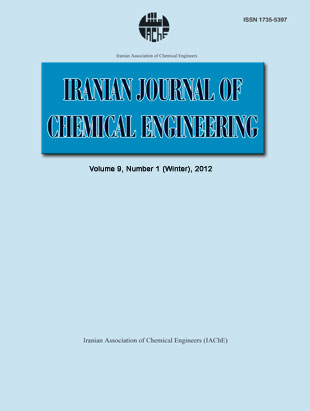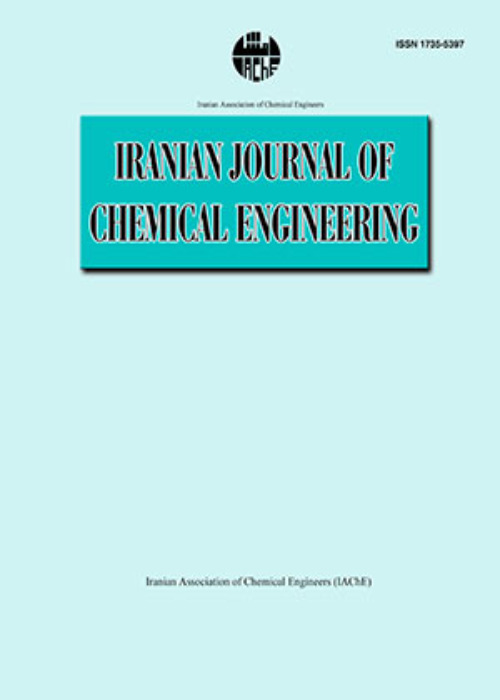فهرست مطالب

Iranian journal of chemical engineering
Volume:9 Issue: 1, Winter 2012
- تاریخ انتشار: 1391/03/23
- تعداد عناوین: 7
-
-
Page 3Electricity generation in a duel chamber microbial fuel cell (MFC) consisting of graphite anode electrode, platinum cathode electrode and Nafion 117 membrane was investigated. Anaerobic sludge was used as the source of microorganisms in the anode chamber. Acetic acid as the sole carbon source along with other nutrients was added to the anode chamber in a batch or repeated-batch modes. System curves and polarization curves were obtained in different operational conditions and the internal resistance of the system was calculated. Electricity generation by MFC in both batch and repeated-batch modes was modeled using a biofilm based hypothesis and the results were compared with experimental data.Keywords: Microbial Fuel Cell, Biofilm Based Model, Electricity Generation
-
Page 12This work deals with estimation of temperature dependent binary interaction parameters (kij) for binary systems containing CO2 using the Soave-Redlich-Kwong equation of state with a group contribution method. In this paper six groups, namely CH3, CH2, CH, CH4 (methane), C2H6 (ethane), and CO2 (carbon dioxide) are defined and their relevant values of group interaction parameters are optimized. Using this method, it is possible to estimate the kij of any mixture containing carbon dioxide and hydrocarbons at any temperature along the coexistence curve. The results obtained in this study are, in most cases, accurate.Keywords: Binary Interaction Parameter_Carbon Dioxide_Equation of State_Group Contribution_Vapor – liquid Equilibria
-
Page 23In the present paper laminar flow forced convective heat transfer of CuO/water nanofluid in a triangular duct under constant wall temperature condition is investigated numerically. Sometimes, because of pressure drop limitations the need for noncircular ducts arises in many heat transfer applications. We used nanofluid instead of pure fluid because of its potential to increase heat transfer of system. In this paper, the effect of parameters such as nanoparticles diameter, nanoparticles concentration, type of nanoparticles and heat transfer comparison between nanofluid and pure fluid is studied. Comparison of convective heat transfer of nanofluid in isosceles triangular ducts with various apex angles is also presented. In this study, for the presence of nanoparticles, the dispersion model and for solving differential equations, the finite difference method is used. Numerical results indicate an enhancement of heat transfer of fluid with changing to the suspension of nanometer-sized particles in the triangular duct. Results also defined that equilateral triangular duct has a maximum heat transfer in comparison with other types of isosceles triangular duct.Keywords: Heat transfer Enhancement, Triangular Duct, CuO, water Nanofluid
-
Page 33The boundary layer convective heat transfer equations with low pressure gradient over a flat plate are solved using Homotopy Perturbation Method (HPM), which is one of the semi-exact methods. The nonlinear equations of momentum and energy solved simultaneously via HPM are in good agreement with results obtained from numerical methods. Using this method, a general equation in terms of Pr number and pressure gradient (λ) is derived which can be used to investigate velocity and temperature profiles in the boundary layer.Keywords: Homotopy Perturbation Method (HPM), Boundary Layer Convective Heat Transfer, Pressure Gradient
-
Page 40Eventual realization of a hydrogen economy requires cheap and readily available hydrogen sources and a technology to convert them into pure hydrogen in an efficient and sustainable manner. The objective of this paper is the computational investigation of the hydrogen production through thermal decomposition of sour natural gases containing CH4 and H2S inside a solar reactor. In this study a solar reactor has been used to absorb solar power and allow it to concentrate in a graphite nozzle in the middle of the reactor and transfer it to a flow reactant thereafter. From an economical standpoint, the main issue is the production of two valuable products, hydrogen (H2) and a high-value nano-material of carbon. The effects of H2S to CH4 feed ratio and reactor temperature on hydrogen, carbon black, S2 and CS2 formation are investigated. The results show complex behavior in the products because of the difference in CH4 and H2S pyrolysis temperatures. It can be seen that for H2S/CH4>2, the yields of H2 and CS2 reach a local and global maximum at H2S/CH4=5, respectively. A comparison performed between the presented results and the results of Towler and Lynn, and Abanades demonstrates a good agreement.Keywords: Hydrogen Sulfide, Pyrolysis, Solar Reactor, Hydrogen, Sulfur Compound
-
Page 50In this study, a kinetic model is proposed for Sunflower oil methanolysis in which the effect of the interfacial area on the reaction system has been investigated. The model is based on the combination of mass transfer and kinetics. Rate constant of the reaction is obtained by fitting of the experimental data with the model. Based on this model, activation energy is equal to E/R=3390 K. This model was applied to the transesterification of soybean oil with some modifications on Misek’s equation and interfacial tension correlation. Methyl ester production at two different mixing intensities was evaluated. By using this model, theoretical conversion is calculated and is compared with the experimental data taken from literature. An acceptable agreement has been obtained between two sets of data. Based on the experimental data shown in the paper, agitator speed has no significant effect on the conversion. Therefore, it can be concluded that at a temperature of 55C or higher, the model parameter approaches to the rate constant of reaction and the agitation speed does not affect the kinetics.Keywords: Sunflower Oil, Methanolysis, Kinetic Model, Interfacial Effects
-
Page 60Creep and stress relaxation of a polypropylene (PP)-based copolymer, a metallocene-prepared linear low density polyethylene (m-LLDPE) and their m-LLDPE/PP blends have been investigated. Struik and Nutting relationships were used for fitting the data obtained from the creep experiments. A relatively good agreement was found between the Struik model and the experimental data obtained from PP and the 50/50 blend, however, the results showed that the validity of the model is less for the m-LLDPE itself. A good correlation was also found for the Nutting relationship and the experimental data. Maxwell and Kohlrausch-Williams-Watts (KWW) equations were used to fit the data obtained from stress relaxation experiments. The results indicated that while the Maxwell model was not good enough to predict the stress relaxation time, KWW model could fit the data much better. Analysis of the data with KWW equation revealed that the relaxation time increased with m-LLDPE content, but not significantly. However, the factor that describes the width of relaxation time distribution reduced with m-LLDPE, showing that m-LLDPE had the broadest relaxation time distribution compared to that of PP and the blends.Keywords: Metallocene, prepared Polyethylene, Polypropylene, Blend, Stress Relaxation, Creep


